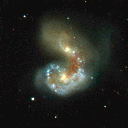To illustrate this difference, consider building a scale model of our galaxy in which the stars are represented by ping-pong balls. In this model, the distance between the Sun and Alpha Centauri will be 1100 kilometers (the distance between Columbus and Jacksonville, Florida). Now consider a scale model of the universe in which individual galaxies are represented by ping-pong balls. In this model, the Milky Way Galaxy and the Andromeda Galaxy will be a pair of ping-pong balls only 1 meter apart.

Computer simulations of merging galaxies are amusing to watch -- they compress hundreds of millions of years into a few seconds of screen time. The Space Telescope Science Institute has both Mpeg and QuickTime videos of a computer simulation of the merger of the ``Mice''.
Although stars don't collide when two galaxies merge, the much larger gas clouds do. The clouds in the two galaxies slam into each other violently. Shock waves from the collision run through the clouds and trigger the collapse of dark nebulae to form stars. Thus, if the two colliding galaxies are rich in gas, their merger will be accompanied by a burst of star formation.
Gas-rich galaxies undergoing mergers generally show the signs of recent star formation. For example:

Spiral galaxies are ordered systems. All the
stars in the spiral's disk go around the center
on circular orbits, in the same direction.
Elliptical galaxies, by contrast, are very
disordered systems. The stars in the elliptical
galaxy are on orbits of all eccentricities,
oriented randomly. Elliptical galaxies, in sort,
are not tidy.
Galaxy mergers are like car crashes. When you collide two neat, orderly sports cars, you don't get a neat, orderly SUV. Instead you get a disordered, chaotic tangle of metal. Similarly, when you collide two neat, orderly spiral galaxies, you don't get a neat, orderly bigger spiral. Instead you get a disordered, chaotic elliptical galaxy.
Elliptical galaxies are found most frequently in
rich clusters because rich clusters are crowded
with many galaxies, and collisions are frequent.
Spiral galaxies are found most frequently in poor
clusters because poor clusters contain few galaxies,
spaced relatively far apart, and collisions are less
frequent.
The giant elliptical galaxies found near the center of rich clusters are huge, containing about a trillion stars apiece. They have gradually grown to this immense size by ``cannibalizing'' smaller galaxies. In many cases, you can see the partially ``digested'' smaller galaxies as luminous spots within the giant galaxy that has engulfed it.
Collisions do occur from time to time within poor clusters. For instance, within the Local Group itself, our galaxy and the Andromeda Galaxy are falling toward each other at a speed of 300 kilometers/sec. About 3 billion years from now, they will be close enough together to distort each other tidally, producing long tails. About 4 or 5 billion years from now, they will have merged into a single (badly mis-shapen) galaxy. About 6 billion years from now, all the stars from the two galaxies, as well as the stars that formed when they merged, will have settled down into a single giant elliptical galaxy.
In the past, the average size of galaxies
was smaller than it is now. The average size
has grown thanks to mergers.
In the past, the universe had more spiral galaxies
than it does now. The spiral galaxies have been
converted to elliptical galaxies thanks to mergers.
Updated: 2003 Feb 26
Copyright © 2003, Barbara Ryden